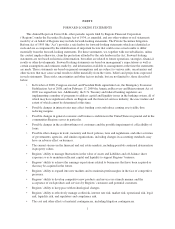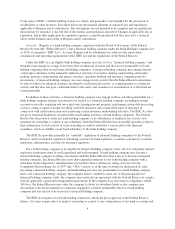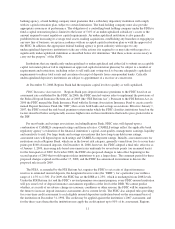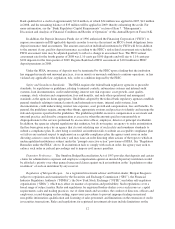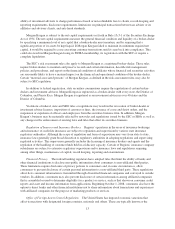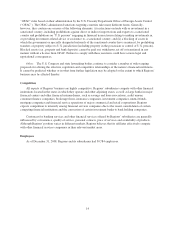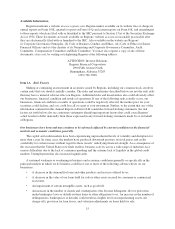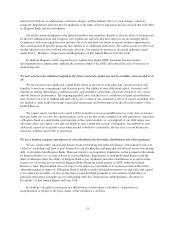Regions Bank 2008 Annual Report Download - page 19
Download and view the complete annual report
Please find page 19 of the 2008 Regions Bank annual report below. You can navigate through the pages in the report by either clicking on the pages listed below, or by using the keyword search tool below to find specific information within the annual report.The guidelines also provide that bank holding companies experiencing internal growth or making acquisitions
will be expected to maintain strong capital positions substantially above the minimum supervisory levels without
significant reliance on intangible assets. Furthermore, the Federal Reserve has indicated that it will consider a
“tangible Tier 1 Capital leverage ratio” (deducting all intangibles) and other indicators of capital strength in
evaluating proposals for expansion or new activities.
A subsidiary bank is subject to substantially similar risk-based and leverage capital requirements as those
applicable to Regions. Regions Bank was in compliance with applicable minimum capital requirements as of
December 31, 2008. Neither Regions nor Regions Bank has been advised by any federal banking agency of any
specific minimum capital ratio requirement applicable to it as of December 31, 2008.
In 2004, the Basel Committee on Banking Supervision published a new set of risk-based capital standards
(“Basel II”) in order to update the original international capital standards that had been put in place in 1988
(“Basel I”). Basel II provides two approaches for setting capital standards for credit risk—an internal ratings-
based approach tailored to individual institutions’ circumstances and a standardized approach that bases risk-
weighting on external credit assessments to a much greater extent than permitted in the existing risk-based capital
guidelines. Basel II also would set capital requirements for operational risk and refine the existing capital
requirements for market risk exposures. The U.S. banking and thrift agencies are developing proposed revisions
to their existing capital adequacy regulations and standards based on Basel II. A definitive final rule for
implementing the advanced approaches of Basel II in the United States, which applies only to internationally
active banking organizations, or “core banks” (defined as those with consolidated total assets of $250 billion or
more or consolidated on-balance sheet foreign exposures of $10 billion or more) became effective on April 1,
2008. Other U.S. banking organizations may elect to adopt the requirements of this rule (if they meet applicable
qualification requirements), but are not required to comply. The rule also allows a banking organization’s
primary Federal supervisor to determine that application of the rule would not be appropriate in light of the
bank’s asset size, level of complexity, risk profile or scope of operations. Regions Bank is currently not required
to comply with Basel II.
In July 2008,the agencies issued a proposed rule that would provide banking organizations that do not use
the advanced approaches with the option to implement a new risk-based capital framework. This framework
would adopt the standardized approach of Basel II for credit risk, the basic indicator approach of Basel II for
operational risk, and related disclosure requirements. While this proposed rule generally parallels the relevant
approaches under Basel II, it diverges where United States markets have unique characteristics and risk profiles,
most notably with respect to risk weighting residential mortgage exposures. Comments on the proposed rule were
due to the agencies by October 27, 2008, but a definitive final rule had not been issued as of December 31, 2008.
The proposed rule, if adopted, will replace the agencies’ earlier proposed amendments to existing risk-based
capital guidelines to make them more risk sensitive (formerly referred to as the “Basel I-A” approach)
Failure to meet capital guidelines could subject a bank to a variety of enforcement remedies, including the
termination of deposit insurance by the FDIC, and to certain restrictions on its business. See “Regulatory
Remedies under the FDIA” below.
Support of Subsidiary Banks. Under Federal Reserve policy, Regions is expected to act as a source of
financial strength to, and to commit resources to support, its subsidiary bank. This support may be required at
times when, absent such Federal Reserve policy, Regions may not be inclined to provide it. In addition, any
capital loans by a bank holding company to its subsidiary bank are subordinate in right of payment to deposits
and to certain other indebtedness of such subsidiary bank. In the event of a bank holding company’s bankruptcy,
any commitment by the bank holding company to a federal bank regulatory agency to maintain the capital of a
subsidiary bank will be assumed by the bankruptcy trustee and entitled to a priority of payment.
Cross-Guarantee Provisions. Each insured depository institution “controlled” (as defined in the BHC Act)
by the same bank holding company can be held liable to the FDIC for any loss incurred, or reasonably expected
9




